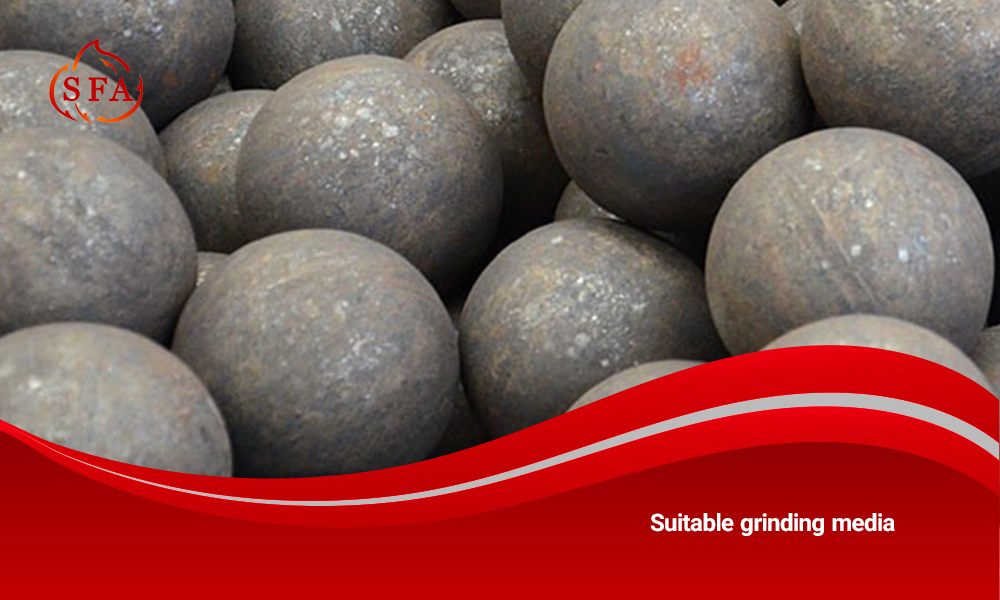

How to Optimize Your Cement Mill with the Right Grinding Media
The cement industry is one of the world’s most vital sectors. It plays a key role in infrastructure development and construction projects. The cement mill, known as the beating heart of production, directly affects cement quality, production costs, and energy consumption through its performance.
One of the key factors in optimizing cement mill performance is the proper selection of grinding balls, or suitable grinding media. These balls are essential for grinding raw materials and clinker. They also enhance overall productivity by reducing energy use, increasing production capacity, and improving product quality.
In this article, we intend to share our experiences and specialized solutions in the field of selecting Suitable Grinding Media for optimizing a cement mill from the website of Atashgah Sepahan Steel Foundry Industries. We will also introduce the company’s production and export capabilities and capacities to present a true picture of the company’s expertise and technical knowledge.
The Role of Suitable Grinding Media in Cement Mill Optimization
The correct selection of grinding balls has a very important impact on increasing the productivity and quality of the process. The intelligent use of Suitable Grinding Media reduces energy consumption and significantly improves the quality of the produced cement. These balls are produced in different sizes and materials, and each type is designed for specific grinding conditions.
1. Definition of Grinding Balls
Abrasive balls, also known as grinding balls, are the most important grinding media in cement mills. These balls grind the raw materials uniformly as the mill rotates, significantly increasing both product quality and production efficiency. Balls are usually made of steel, cast iron, or special alloys, and their careful and appropriate selection can reduce equipment wear, lower energy consumption, and improve the overall performance of the mill.
2. Types of Mill Balls
- Forged Steel Balls: High impact resistance, suitable for large mills and harsh conditions.
- Cast Iron Balls: More economical, but have less resistance to breakage.
- High Chrome Alloy Balls: Excellent abrasion resistance, suitable for heavy and highly loaded mills.
- Ceramic Balls: Mostly used in specialized industries and less used in cement
3. Criteria for proper selection
- Hardness and wear resistance: The harder the ball, the longer its durability and lifespan in the grinding process.
- Dimensions and size distribution: Choosing the right size of balls plays an important role in increasing the efficiency and effectiveness of the mill.
- Chemical composition: The presence of alloying elements such as chromium and molybdenum increases the strength and wear resistance of the balls.
- Mill operating conditions: Factors such as rotation speed, type of feed, and internal design of the mill have a great impact on the selection of the type and characteristics of the balls.
4. The impact of the right choice on mill performance
- Energy savings of up to 10%: Selecting the right balls makes the grinding process more efficient and reduces energy waste.
- Increased production capacity by up to 15%: Better mill performance enables higher output within the same time, boosting overall productivity.
- Improved cement quality: Precise control of grinding and uniform particle size enhance the quality and stability of the final product.
- Lower maintenance costs: Using high-quality balls reduces wear on internal mill parts and extends equipment life.
Key Points in Selecting Suitable Grinding Media
This section discusses the most important points and key criteria for selecting the right grinding balls to maximize mill performance and efficiency.
1. Review of Mill Operating Conditions
To properly select the mill balls, the operating conditions of the machine must first be carefully examined. Factors such as the mill rotation speed, feed type and characteristics, internal design of the mill body, and actual machine capacity all play a decisive role in the appropriate selection of balls. By considering all these parameters simultaneously, the ideal combination of balls can be selected that, in addition to improving the mill efficiency, reduces energy consumption, and increases the quality of the final product.
2. Hardness and wear resistance
Balls must have sufficient hardness to withstand pressure and wear over time. However, excessive hardness can cause the balls to become brittle and prone to sudden breakage, which increases maintenance costs. Therefore, creating the right balance between the hardness and flexibility of the balls is the key factor in achieving optimal performance and extending their useful life.
3. Size and size distribution of the pellets
The combination of different sizes allows for faster crushing of coarse particles and the production of uniform fine particles. This variety of sizes makes the crushing process more balanced, efficient and of higher quality, and the final product is at a higher level in terms of uniformity.
4. Chemical composition and alloy
Alloy elements such as chromium and molybdenum increase the resistance of the pellets to wear and impact. This feature allows the pellets to have a longer life in harsh conditions, maintain consistent crushing quality, and reduce the cost of replacing or repairing equipment.
5. Life-cycle Cost
In some cases, choosing pellets with a higher initial price can reduce the overall cost of production in the long run, as these pellets are more durable and resistant to wear. Such a choice provides greater stability in the cement grinding process and significantly increases production efficiency.
6. Compatibility with the type of cement produced
Some cements require special grinding conditions due to their chemical composition or specific physical properties. In these cases, a ball must be selected that is compatible with the specific conditions and provides the best performance. This smart choice both improves product quality and optimizes productivity and costs.
Click to read the article «What makes a ball mill grinder more efficient?
7. Practical testing and evaluation
Before a type of ball is widely used, it is necessary to test samples under actual mill conditions. These tests show the actual performance of the balls and identify their strengths and weaknesses. Practical evaluation makes for a more scientific, optimal and production-appropriate selection, and reduces the risk of error.
Sepahan Atashgah Steel Foundry Industries | Pioneer in the production of mill balls and industrial parts
Atashgah Sepahan Steel Foundry has over three decades of experience in the foundry industry. We are one of the leading manufacturers of suitable grinding media and industrial parts in the country. With seven melting furnaces and an annual capacity of more than 25,000 tons, we have earned a strong position in the cement, steel, and mining industries.
Our products include special cement grinding balls, steel and cast iron parts for the mining industry, and heat and abrasion resistant parts for the steel and copper industries. We apply strict quality control at all stages of production, from the selection of raw materials to heat treatment, so that a product meets global standards reaches the customer.
Our customers are not only from domestic industries; many reputable manufacturers in the Middle East and European markets have also trusted our products, which indicates the high quality of the products and the international competitiveness of the company.
Our professional consultants, along with the technical and production team, are always ready to provide the best solutions tailored to the specific needs of each customer. This consultation-oriented approach has made cooperation with us not just a simple purchase, but a long-term and sustainable partnership that both increases productivity and reduces costs.
The company’s management, led by Mr. Mohsen Ahmadi, with a strategic vision and development-oriented approach, has played a very important role in expanding exports and enhancing the brand position of Atashgah Sepahan Steel Foundry Industries.
Conclusion
In the cement industry, choosing the right grinding balls is vital for mill performance and product quality. The cement mill, as the heart of the production line, works best when the balls are properly selected for material, size, hardness, and chemical composition.
Using high-quality balls that match the mill’s operating conditions can lower energy use and raise production capacity. They also improve cement quality and reduce maintenance costs. Finding the right balance between hardness, flexibility, wear resistance, and alloy composition extends ball life and stabilizes the grinding process.
Smart and precise selection of balls improves both mill performance and product quality. It also boosts production efficiency and makes the process more sustainable.


